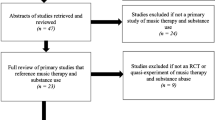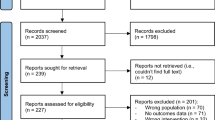Abstract
Objectives
The aim of this review was to assess the effectiveness of music therapy on improving the mental health of offenders in correctional settings.
Methods
Multiple databases and journals were searched to identify randomized controlled trials and quasi-randomized controlled trials of music therapy for offenders in correctional settings.
Results
Five studies (n = 409; predominantly male) were included in random-effects meta-analyses. Music therapy was effective for promoting offenders’ self-esteem (Hedges’ g = 0.55, p < 0.001) and social functioning (g = 0.35, p < 0.05). Effects on anxiety and depression depended on the number of sessions. For both outcomes, the studies with 20 or more sessions had larger effects than the study that had fewer than 20 sessions, and this difference was statistically significant (Q = 11.88, df = 1, p < 0.001, anxiety; Q = 9.16, df = 1, p = 0.002, depression). No significant effects were found on behavior management or between different music therapy approaches.
Conclusions
Music therapy may be helpful for offenders to improve mental health. Future studies should consider including offenders of both genders, using larger sample sizes, and examining long-term effects. Publication bias may be an issue for this review given the small number of studies and the small sample sizes.






Similar content being viewed by others
References
Aigen, K. (2007). In defense of beauty: a role for the aesthetic in music therapy theory: Part I: The development of aesthetic theory in music therapy. Nordic Journal of Music Therapy, 16(2), 112–128.
Allermann, E. (1989). Musiktherapeutische Arbeit mit verwahrlosten Jugendlichen: Ideen für ein Konzept. Music therapy with juvenile delinquents. Musiktherapeutische Umschau, 10(4), 267–274.
Anumba, N., Dematteo, D., & Heilbrun, K. (2012). Social functioning, victimization, and mental health among female offenders. Criminal Justice and Behavior, 39(9), 1204–1218. doi:10.1177/0093854812443489.
Baumeister, R. F., Campbell, J. D., Krueger, J. I., & Vohs, K. D. (2003). Does high self-esteem cause better performance, interpersonal success, happiness, or healthier lifestyles? Psychological Science in the Public Interest, 4(1), 1–44.
Bonta, J., & Andrews, D. A. (2007a). Risk–need–responsivity model for offender assessment and rehabilitation. Ottawa, Canada: Carlton University/Public Safety Canada.
Bonta, J., & Andrews, D. A. (2007b). Risk–need–responsivity model for offender assessment and rehabilitation. Rehabilitation, 6, 1–22.
Bruscia, K. (1998). Defining music therapy (2nd ed.). Gilsum, NH: Barcelona.
Chambers, C. (2008). Song and metaphoric imagery in forensic music therapy. Doctoral dissertation, University of Nottingham, Nottingham. Retrieved from: http://eprints.nottingham.ac.uk/10833/.
Chen, X. J., Hannibal, N., & Gold, C. (2015a). Randomised trial of group music therapy with Chinese prisoners. Impact on anxiety, depression, and self-esteem. International Journal of Offender Therapy and Comparative Criminology. doi:10.1177/0306624X15572795.
Chen, X. J., Hannibal, N., Xu, K., & Gold, C. (2014). Group music therapy for prisoners: protocol for a randomised controlled trial. Nordic Journal of Music Therapy, 23, 224–241. doi:10.1080/08098131.2013.854268.
Chen, X. J., Leith, H., Aarø, L. E., Manger, T., & Gold, C. (2015b). Music therapy for improving mental health in offenders: protocol for a systematic review and meta-analysis. Retrieved from eprint arXiv:1503.06524: http://arxiv.org/ftp/arxiv/papers/1503/1503.06524.pdf
Codding, P. A. (2002). A comprehensive survey of music therapists practicing in correctional psychiatry: demographics, conditions of employment, service provision, assessment, therapeutic objectives, and related values of the therapist. Music Therapy Perspectives, 20(2), 56–68.
Cohen, J. M. (1987). Music therapy with the overcontrolled offender: theory and practice. The Arts in Psychotherapy, 14, 215–221.
Cohen, M. L. (2009). Choral singing and prison inmates: influences of performing in a prison choir. Journal of Correctional Education, 60(1), 52–65.
Day, A., & Doyle, P. (2010). Violent offender rehabilitation and the therapeutic community model of treatment: towards integrated service provision? Aggression and Violent Behavior, 15(5), 380–386.
De Bedout, J. K. (1994). The effect of a music activity versus a non-music activity on verbalization and values clarification during group counseling with juvenile offenders. Unpublished master’s thesis, Florida State University. Available from: http://worldcat.org, WorldCat database.
Erkkilä, J., Punkanen, M., Fachner, J., Ala-Ruona, E., Pöntiö, I., Tervaniemi, M., Vanhala, M., & Gold, C. (2011). Individual music therapy for depression: randomised controlled trial. British Journal of Psychiatry, 199, 132–139. doi:10.1192/bjp.bp.110.085431.
Gold, C. (2008). Effects of music therapy for prison inmates. doi:10.1186/ISRCTN22518605. ISRCTN22518605. http://www.isrctn.com/ISRCTN22518605.
Gold, C., Assmus, J., Hjørnevik, K., Qvale, L. G., Brown, F. K., Hansen, A. L., Waage, L., & Stige, B. (2014). Music therapy for prisoners. Pilot randomised controlled trial and implications for evaluating psychosocial interventions. International Journal of Offender Therapy and Comparative Criminology, 58, 1520–1539. doi:10.1177/0306624x13498693.
Gold, C., Mössler, K., Grocke, D., Heldal, T. O., Tjemsland, L., Aarre, T., Aarø, L. E., Rittmannsberger, H. G., Stige, B. C., Assmus, J., & Rolvsjord, R. (2013). Individual music therapy for mental health care clients with low therapy motivation: multicentre randomised controlled trial. Psychotherapy and Psychosomatics, 82(5), 319–331. doi:10.1159/000348452.
Gold, C., Solli, H. P., Krüger, V., & Lie, S. A. (2009). Dose–response relationship in music therapy for people with serious mental disorders: systematic review and meta-analysis. Clinical Psychology Review, 29, 193–207.
Hakvoort, L., & Bogaerts, S. (2013). Theoretical foundations and workable assumptions for cognitive behavioral music therapy in forensic psychiatry. The Arts in Psychotherapy, 40, 192–200.
Hakvoort, L., Bogaerts, S., Thaut, M. H., & Spreen, M. (2013). Influence of music therapy on coping skills and anger management in forensic psychiatric patients: an exploratory study. International Journal of Offender Therapy and Comparative Criminology, 0306624X13516787.
Hartley, S., Barrowclough, C., & Haddock, G. (2013). Anxiety and depression in psychosis: a systematic review of associations with positive psychotic symptoms. Acta Psychiatrica Scandinavica, 128(5), 327–346. doi:10.1111/acps.12080.
Harvey, J. (2011). Acknowledging and understanding complexity when providing therapy in prisons. European Journal of Psychotherapy & Counselling, 13(4), 303–315. doi:10.1080/13642537.2011.625204.
Higgins, J. P. T., & Green, S. (Eds.). (2011). Cochrane handbook for systematic reviews of interventions. Version 5.1.0 (updated March 2011).
Hoskyns, S. (1988). Studying group music therapy with adult offenders: research in progress. Psychology of Music, 16(1), 25–41. doi:10.1177/0305735688161003.
James, D. J., & Glaze, L. E. (2006). Mental health problems of prison and jail inmates. U.S. Department of Justice.
Johnson, E. R. (1981). The role of objective and concrete feedback in self-concept treatment of juvenile delinquents in music therapy. Journal of Music Therapy, 18(3), 137–147.
Jolliffe, D., & Farrington, D. P. (2004). Empathy and offending: a systematic review and meta-analysis. Aggression and Violent Behavior, 9, 441–476.
Juslin, P. N., & Sloboda, J. A. (2010). Handbook of music and emotion. Oxford: Oxford University Press.
Kennedy, R. (1998). The effects of musical performance, rational emotive therapy and vicarious experience on the self-efficacy and self-esteem of juvenile delinquents and disadvantaged children. Unpublished doctoral dissertation, University of Kansas.
Leith, H. (2011). Mixed methods exploration of music therapy and the resettlement of women prisoners with non-psychotic mental health problems [elaborate proposal for PhD study]. Aalborg: Aalborg University.
Leuterio, R. (2008). Effectiveness of meditation and music technique as a mechanism of wellness for incarcerated drug addicts. International Journal of Psychology, 43(3–4), 284.
Lipsey, M. W., & Cullen, F. T. (2007). The effectiveness of correctional rehabilitation: a review of systematic reviews. Annual Review of Law & Social Science, 3, 297–320.
Loth, H. (1994). Music therapy and forensic psychiatry—choice, denial and the law. Journal of British Music Therapy, 8(2), 10–18.
Loth, H. (1996). Music therapy. In C. Cordess & M. Cox (Eds.), Forensic psychotherapy: crime, psychodynamic and the offender patient. London: Jessica Kingsley.
Maratos, A., Gold, C., Wang, X., & Crawford, M. (2008). Music therapy for depression. The Cochrane Library. doi:10.1002/14651858.CD004517.pub2
Mössler, K., Chen, X. J., Heldal, T. O., & Gold, C. (2011). Music therapy for people with schizophrenia and schizophrenia-like disorders. Cochrane Database of Systematic Reviews. doi:10.1002/14651858.CD004025.pub3.
Nolan, P. (1983). Insight therapy: guided imagery and music in a forensic psychiatric setting. Music Therapy, 3(1), 43–51.
Nurse, J., Woodcock, P., & Ormsby, J. (2003). Influence of environmental factors on mental health within prisons: focus group study. British Medical Journal, 327(7413), 480. doi:10.1136/bmj.327.7413.480.
O’Grady, L. (2011). The therapeutic potentials of creating and performing music with women in prison: a qualitative case study. Qualitative Inquiries in Music Therapy, 6, 122–152.
O’Grady, L., Rolvsjord, R., & McFerran, K. (2015). Women performing music in prison: an exploration of the resources that come into play. Nordic Journal of Music Therapy, 24(2), 123–147. doi:10.1080/08098131.2013.877518.
Oakley, C., Hynes, F., & Clark, T. (2009). Mood disorders and violence: a new focus. Advances in Psychiatric Treatment, 15(4), 263–270. doi:10.1192/apt.bp.107.005413.
Prison Reform Trust. (2011). Bromley briefings prison factfile. London.
Procter, S. (2011). Reparative musicing: thinking on the usefulness of social capital theory within music therapy. Nordic Journal of Music Therapy, 20(3), 242–262.
Rio, R. E., & Tenney, K. S. (2002). Music therapy for juvenile offenders in residential treatment. Music Therapy Perspectives, 20, 89–97.
Skaggs, R. (1997). Music-centered creative arts in a sex offender treatment program for male juveniles. Music Therapy Perspectives, 15, 73–78.
Smeijsters, H. (2012). Analogy and metaphor in music therapy. Theory and practice. Nordic Journal of Music Therapy, 21(3), 227–249.
Smeijsters, H., & Cleven, G. (2006). The treatment of aggression using arts therapies in forensic psychiatry: results of a qualitative inquiry. The Arts in Psychotherapy, 33(1), 37–58. doi:10.1016/j.aip.2005.07.001.
Stern, D. (2010). The issue of vitality. Nordic Journal of Music Therapy, 19(2), 88–102.
Thaut, M. H. (1989). The influence of music therapy interventions on self-rated changes in relaxation, affect, and thought in psychiatric prisoner-patients. Journal of Music Therapy, 26(3), 155–166.
Tuastad, L., & O’Grady, L. (2013). Music therapy inside and outside prison—a freedom practice? Nordic Journal of Music Therapy, 22(3), 210–232. 10.1080/08098131.2012.752760
Tuastad, L., & Stige, B. (2014). The revenge of Me and THE BAND’its: a narrative inquiry of identity constructions in a rock band of ex-inmates. Nordic Journal of Music Therapy, 24(3), 252–275. doi:10.1080/08098131.2014.967713.
Tyson, E. H. (2002). Hip hop therapy: an exploratory study of a rap music intervention with at-risk and delinquent youth. Journal of Poetry Therapy, 15(3), 131–144.
Wang, B., Li, B., & Hu, J. (2007). 累犯人格障碍的相关研究. [The investigation on personality disorders of recidivists]. 精神卫生期刊, 20(2), 81–83.
Ward, K. L. (1996). The effects of music therapy with chemically dependent offenders in a women’s prison. Unpublished doctoral dissertation, Florida State University. Available from: http://worldcat.org, WorldCat database.
Ward, T., & Maruna, S. (2007). Rehabilitation: beyond the risk paradigm. London: Routledge.
World Health Organization (WHO). (2007). Mental health, human rights and legislation information sheet. Retrieved from: http://www.who.int/mental_health/policy/legislation/policy/en/
Zeuch, A., & Hillecke, T. (2004). Ergebnisse musiktherapeutischer Entspannung im sozialtherapeutischen Strafvollzug: Eine qualitativ-quantitative Orientierungsstudie [Results of music therapeutic relaxation in a social-therapeutic penal system: a qualitative-quantitative orientation study]. Musik-, Tanz- und Kunsttherapie, 15(1), 16–23.
Acknowledgments
We would like to acknowledge the help of the Cochrane Developmental, Psychosocial and Learning Problems Group (CDPLPG) with the methodological questions as well as with providing search results.
Author information
Authors and Affiliations
Corresponding author
Additional information
Note: Co-author H.L. died after the initial submission of this manuscript, but before the publication of its final version. The remaining authors would like to acknowledge her contribution to the conduct and preparation of this work. She did approve the initial submitted version of the manuscript.
Rights and permissions
About this article
Cite this article
Chen, X.J., Leith, H., Aarø, L.E. et al. Music therapy for improving mental health problems of offenders in correctional settings: systematic review and meta-analysis. J Exp Criminol 12, 209–228 (2016). https://doi.org/10.1007/s11292-015-9250-y
Published:
Issue Date:
DOI: https://doi.org/10.1007/s11292-015-9250-y




